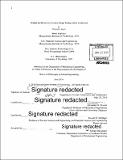| dc.contributor.advisor | Alexander H. Slocum. | en_US |
| dc.contributor.author | Jonart, Douglas E. (Douglas Edward) | en_US |
| dc.contributor.other | Massachusetts Institute of Technology. Department of Mechanical Engineering. | en_US |
| dc.date.accessioned | 2017-02-22T19:02:21Z | |
| dc.date.available | 2017-02-22T19:02:21Z | |
| dc.date.copyright | 2016 | en_US |
| dc.date.issued | 2016 | en_US |
| dc.identifier.uri | http://hdl.handle.net/1721.1/107074 | |
| dc.description | Thesis: Ph. D. in Ocean Engineering, Massachusetts Institute of Technology, Department of Mechanical Engineering, 2016. | en_US |
| dc.description | Cataloged from PDF version of thesis. | en_US |
| dc.description | Includes bibliographical references. | en_US |
| dc.description.abstract | Substantial submarine procurement and maintenance costs could be saved by extending the submarine propulsion shaft inspection interval from 6 to 12 years as part of the design of the next class of vessels. On existing classes, corrosion fatigue limits this interval, but data on corrosion fatigue life is sparse and incomplete. An existing model from previous research has been updated and stands ready to provide predictions, given more relevant data. Techniques and devices are developed to obtain this data. First, traditional fatigue machines and samples are adapted to provide information on corrosion fatigue on pre-pitted and unpitted samples. Artificial seawater is used for comparative consistency; tests with enzymatic or actual seawater are recommended. Next, direct-current potential drop is proven as a means to detect transitions in the corrosion fatigue failure chain on a bending fatigue specimen exposed to artificial seawater. This method can be used to detect transition of pits to cracks in situ, and it is believed that it can be used to detect ingress of water through protective coatings, which has not previously been measured or credited in a review of predictive models and design life analyses. This technique should be verified and expanded to detect additional transitions and to apply to the devices developed as part of this research. Second, test devices are developed to more accurately reflect the operational submarine propulsion shaft, in terms of loading, environment, and number of test cycles. The benchtop prototype intended to prove the concept has been identified by the Navy as an improvement over existing machines, and is subsequently redesigned as an inexpensive and rapidly deployable test stand for uncoated shaft specimens. The originally envisioned device is also designed and assembled. It leverages non-contact air bearings and motors, as well as flexural pivots, to enable very high cycle fatigue testing while minimizing the parasitic loads imparted on the sample by the test machine. The next recommended step is deployment of this device as a tool for verification testing of fully coated samples, necessary based on the large scope of the desired increase in shaft life. | en_US |
| dc.description.statementofresponsibility | by Douglas E. Jonart. | en_US |
| dc.format.extent | 215 pages | en_US |
| dc.language.iso | eng | en_US |
| dc.publisher | Massachusetts Institute of Technology | en_US |
| dc.rights | MIT theses are protected by copyright. They may be viewed, downloaded, or printed from this source but further reproduction or distribution in any format is prohibited without written permission. | en_US |
| dc.rights.uri | http://dspace.mit.edu/handle/1721.1/7582 | en_US |
| dc.subject | Mechanical Engineering. | en_US |
| dc.title | Methods and devices for corrosion fatigue testing without acceleration | en_US |
| dc.type | Thesis | en_US |
| dc.description.degree | Ph. D. in Ocean Engineering | en_US |
| dc.contributor.department | Massachusetts Institute of Technology. Department of Mechanical Engineering | |
| dc.identifier.oclc | 971133348 | en_US |
